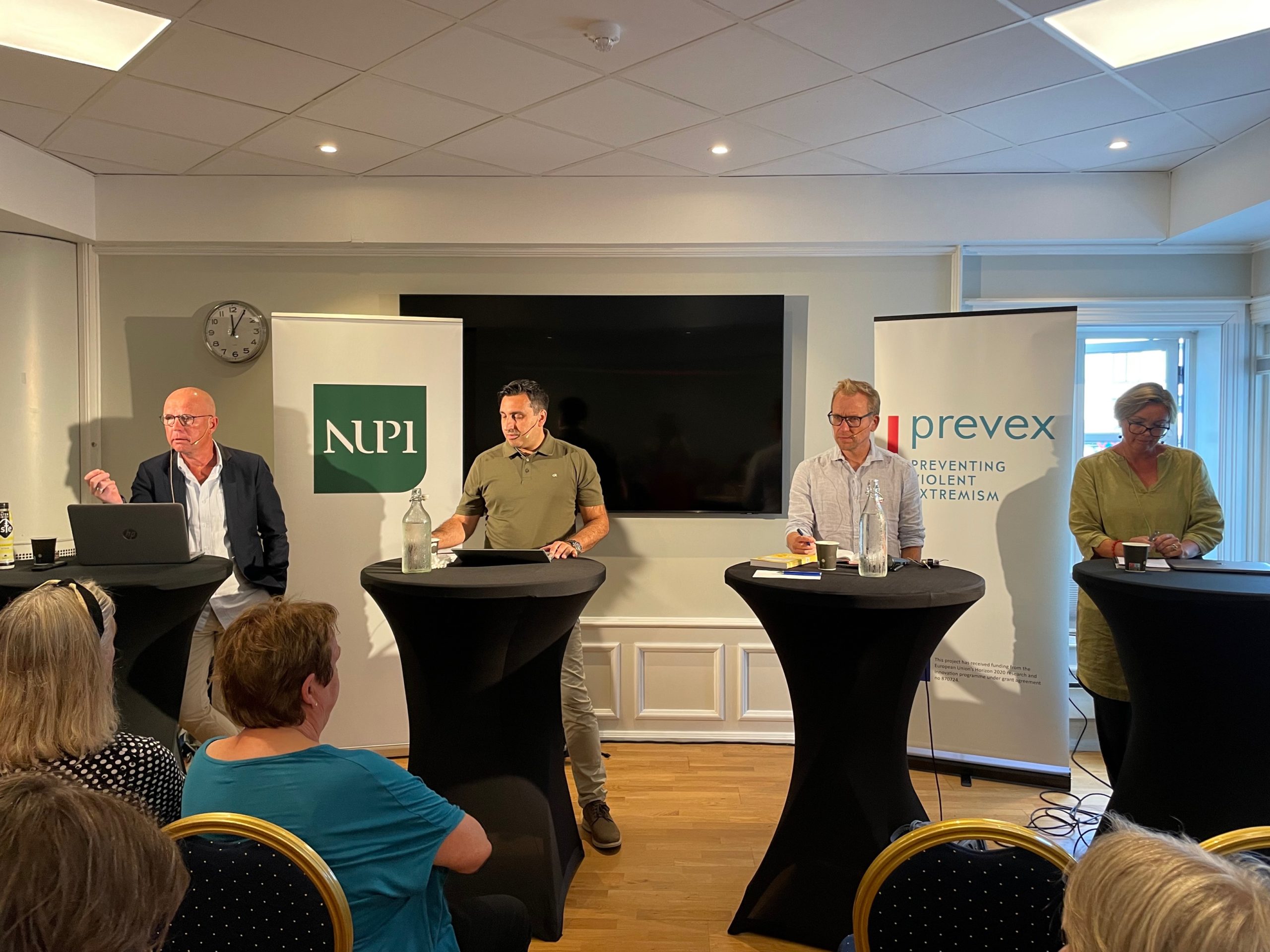On 17 August 2022, NUPI and PREVEX – represented by Research Professor and PI Morten Bøås and Senior Researcher Kari Osland (NUPI) – organised an event at the political event Arendalsuka 2022 in Arendal, Norway. The event, titled ‘Most people are not radicalised’ (Folk flest radikaliseres ikke), addressed the question of why we do not see more violent extremism in enabling environments, and what we can learn from it in the future. In addition to Bøås and Osland, David Hansen (Deputy Head, OsloMet and Researcher, KRUS) and Sveinung Sandberg (Professor, University of Oslo) were also invited to partake in the discussion.
Professor Bøås opened the panel by asking the important and central question: in a world where there are so many reasons to be angry, why aren’t more people radicalised? One important factor is local resilience, Bøås argued, exemplifying with several case studies from the PREVEX universe affected by violent extremism. Furthermore, in regions severely affected by radicalisation and violent extremism, it is important to look at how state authorities have tried to combat and prevent it. In fact, efforts have often been counterproductive, and authorities’ attempts to prevent it have often had the opposite effect. In these enabling environments, local religious authorities with high trust and legitimacy among its people have shown to have a significant impact and be an important mechanism against radicalisation, Bøås argued, using the inter-religious governing council of Mali as an example.
Building on Bøås’ contribution, Senior Researcher Kari Osland uses the example of Bosnia-Herzegovina to highlight the importance of moderate, religious authorities in prevention efforts. Despite having experienced few locally grown terrorist attacks, the country has – like other Balkan countries – had a large number of foreign fighters traveling to conflict zones in Syria and Iraq. There are several factors in Bosnia causing grievances and creating an enabling environment for violent extremism to flourish, among them a conflict-ridden political system set up through the Dayton Agreement, nationalist politicians promoting hate speech along ethnic lines, high unemployment rates and scarcity of resources, as well as the “two schools under one roof”-system. These socioeconomic factors are but a few examples that preserve the stark ethnic dividing lines and reinforce extremist attitudes. In a country like Bosnia, with a low degree of vertical and horizontal trust between people and authorities, moderate religious – and secular – leaders who have high legitimacy and trust among people, have proven to be important in preventing radicalisation in vulnerable communities. Other factors of importance that can strengthen – or weaken – local resilience are the socio-economic situation in each local community, state responses to radicalisation and violent extremism, and opportunities for social mobility.
Drawing parallels to his research in the Norwegian context, Professor and sociologist Sveinung Sandberg state that the radicalisation and violent extremism we see in Norway is different than in countries with other types of institutional arrangements. Radicalisation in Norway stem from criminal milieus and street culture in urban areas, which is confirmed by the fact that two-thirds of Norwegian foreign fighters had criminal background, Sandberg argues. In such cases, he continues, other types of religious authorities become more relevant and important, as these individuals do not have any institutional affiliation to a religious milieu. In fact, everyday resistance from close relatives and friends is found to be the most effective tool against radicalisation in these cases, maybe even more so than state authorities’ prevention efforts. Close relatives and friends with moderate values can have a real impact on a person’s decision on whether to become a foreign fighter or not. If we start recognizing – and not criticizing – these local efforts, we can work more effectively towards strengthening local communities, Sandberg concludes.
Far-right extremists and radical Islamist extremists have many commonalities in terms of life challenges such as marginalisation, substance abuse, and mental health issues, that are often intertwined, according to Researcher David Hansen. A paradox lies in the fact that these individuals are usually perceived as having a strong commitment to religion, while in reality, few have any knowledge of theology, and only know fragments of what jihad can be, based on what they have learned from close relations. However, religion should not be ruled out as a positive driving force; for example, real knowledge of religion, preferably with mentors such as imams, has been found to have a positive impact on convicts serving terror sentences. But for religion to be a positive driving force, individuals must be given space to practice it, Hansen continues. An extreme right-winger who distances him- or herself from far-right ideology through action will be considered de-radicalised, while a radical Islamist who de-radicalise will still be a Muslim, a group that continues to experience low trust in Western societies. This is but one of several factors that cause individuals to become radical, especially among diaspora communities with a high degree of polarisation. The moderate is changing, and we need different interpretations of what the moderate is, depending on where we are and live, David Hansen (OsloMet) concludes.
Following the panel discussion, the audience contributed with comments and questions, and the panelists reflected on what can be done in terms of future prevention efforts. Firstly, strengthening general social crime prevention work can prevent radicalisation at an early stage, through addressing several societal issues that are often intertwined, such as crime, radicalisation and drug use. Second, and in contexts like the Bosnian one, external actors must tread carefully and support change agents in a very subtle way, so as not to undermine local legitimacy.

Watch a video recording of the seminar here.
Read more about the event in the newspaper for Norwegian and international research news, Forskning.no, here.



